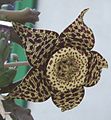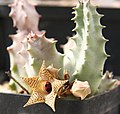Carrion flower
As carrion flowers or carnivorous plants , Ekelblume , plants are commonly referred to, the flowers smell of carrion flow out to koprophile insects such. As carrion beetles , histeridae and carrion flies for pollination lure of the flower. Important are Rafflesia TYPES with the largest flowers in the world, Haselwurz TYPES ( Asarum ) from the family of aristolochiaceae (Aristolochiaceae) and arum ( Arum ) from the family of the arum family (Araceae) and some milkweed plants ( Ceropegia , Stapelia , Huernia , Hoodia or Orbea, among others). In flower ecology they are called so-called deceptive or falling flowers. They attract flies and beetles by imitating carrion or feces, the smell is generated by amines in a special organ. They are greenish-white or red-brown in color and have brown or black spots or they have white spots as "mold imitation". They often have easily movable, brightly shiny hair. It is known that many carrion flowers can heat up the inflorescence, which probably facilitates the release of odorous substances.
The carrion flies pollinate the flowers when they lay their eggs, but the larvae starve to death. This deception is also known as mimicry .
photos
Some species known as carrion flower:
Caralluma acutangula , near Yomboli, Burkina Faso
Hoodia gordonii on site in the Karoo
literature
- Frank Ensinger (ed.): The culture of plants in vessels. 1st edition, Mannheim 2014.
Web links
- Carrion Flower: The Stinking Beauty (accessed October 19, 2015)
- Carrion flower care: what should be considered? (accessed on October 19, 2015)
- Giant carrion flower (accessed October 19, 2015)







